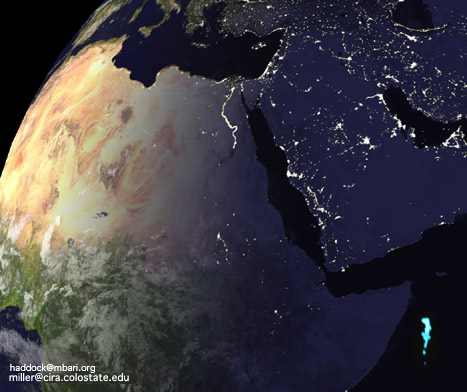
Composite image of earth atlas information and milky-sea data. The bioluminescent feature (lower right) is to scale, but has been colorized and enhanced, so it appears much brighter in relation to the scene than it would naturally. (Do not use this image without permission.)
Spotting a bioluminescent milky sea from space
Milky seas are unusual phenomena which have been noticed by mariners for centuries, but which remain unexplained by scientists. These events are when the surface of the ocean, often from horizon to horizon, glows with a continuous uniform milky light. Although the origins of this light are not well investigated, the most plausible explanation is that it is caused by blooms of bioluminescent bacteria. Dinoflagellates, which cause red tides, flashing waves, and sparkling wakes behind boats, need to be physically stimulated to produce their brief bright flashes.

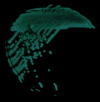
Nonetheless, we believe that given the rare occurrences and limited geographic range of these events, that it is plausible to consider special circumstances might lead to such a bloom of bacteria. After all red tides are exceptional conditions which can have 1000x greater densities of cells than are found naturally in the water. Why can't there be "blue tides" of glowing bacteria when the right combinations of nutrients, temperature, and oxygen coincide?
The light from a milky sea is sometimes described as white, but it is actuallyblue. It may appear white when detected by human night-time vision, using rod photoreceptors that do not distinguish colors.
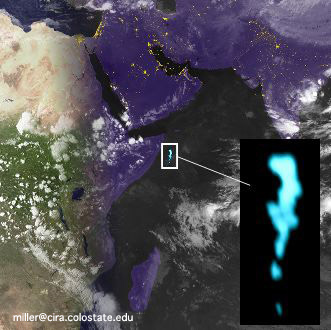
We were recently able to capture the first satellite images of a milky sea -- and of bioluminescence at all, to our knowledge (Miller, et al. 2005). The image above, prepared by Steve Miller of the Naval Research Lab, shows a composite of two different earth atlases (day and night) with actual cloud data and the satellite-detected bioluminescence superimposed. The milky sea data have been colorized to approximate the natural bacterial emission spectrum, since the low-light sensor only perceives light as grey scale.
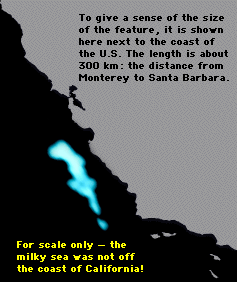
Although published reports of milky seas are rare, they are certainly sighted more frequently than people bother to write them up. With this study, we hope to encourage sailors to notify us of their own milky-sea experiences (since 1992), so we can search the satellite records for other recent occurrences.
In Jules Verne's 1870 novel Twenty Thousand Leagues Under the Sea the submarine Nautilus spent at least a few of those eponymous leagues (one league = three miles) traveling through a milky sea.
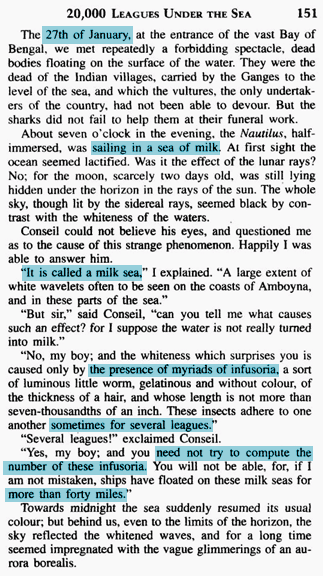
- Our observations and Verne's both take place in January 27th, though more than 100 years apart.
- Verne's narrator reports ships traveling across them for forty miles; Our observation spans more than 100 miles (160 km), covering an area of 15,000 square kilometers -- about the size of Hawaii.
- In the novel, it is said to be impossible to calculate the number of microorganisms (infusoria) involved; we conservatively estimate 4 x 10e22 bacteria, or 40 billion trillion bacteria to be present.
These numbers are almost impossible to understand intuitively, but for comparison, they are about the same as the total number of bacteria estimated to occupy the upper 200 m of the ENTIRE open ocean, and 100 times more than the estimates for ALL bacteria in waters overlying the continental shelf (Whitman, et al. 1998).
Another way to look at it: this is the number of grains of sand it would take to cover the entire earth with a layer 10 cm thick (!).
References and Additional Reading:
- Miller, S.D., S.H.D. Haddock, C.D. Elvidge, T.F. Lee. (2005) Detection of a bioluminescent milky sea from space. Proc. Nat. Acad. Sci. 102:14181-14184. [PDF]
- Herring, P.J., and M. Watson (1993) Milky seas: a bioluminescent puzzle. The Mar. Obsvr. 63:22-30.
- Nealson, K.H. and J.W. Hastings (2006) Quorum sensing on a global scale: massive numbers of bioluminescent bacteria make milky seas Appl. Environ. Microbiol.72:2295-2297. [ PDF file ]
- Lapota, D. et al. (1988) Observations and measurements of planktonic bioluminescence in and around a milky sea. J. Mar. Exp. Mar. Biol. Ecol. 119:55-81.
- Pedros-Alio, C. and R. Simo (2002) Studying marine microorganisms from space.International Microbiology 5:195-200.
- Hastings, J. W., and K. H. Nealson (1977) Bacterial bioluminescence. Annu. Rev. Microbiol. 31:549-595.
- Whitman, W.B, D.C. Coleman, W.J. Wiebe. (1998) Prokaryotes: the unseen majority.Proc. Nat. Acad. Sci. 95:6578-6583.
- NPR story [ Link to Audio File ]




